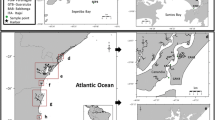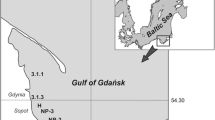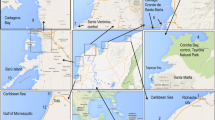Abstract
Butyltin concentrations were determined in sediments, tissues and stomach contents of fish collected in 41 embayments on the East, Gulf and Pacific coasts of the U.S.A. between 1986 and 1991 as part of the National Oceanic and Atmospheric Administration's (NOAA) National Benthic Surveillance Project (NBSP). A total of 99 sediments, 108 fish liver samples from 11 fish species, and 10 composites of fish stomach contents were analyzed for tetrabutylin, tributylin, dibutylin and monobutylin. Tributyltin (TBT) was detected (i.e. > 10 ng/g) in 38 of the sediments samples analyzed and was generally the predominant bulytin present; concentrations of total butyltins ranged from 15 to 1600 ng/g wet weight. The highest concentrations were found in sediments from urban sites, especially sites on the West coast. Many of the fish liver and stomach contents samples also contained butyltins. Tributyltin represented 83 (7.1)% [mean (SEM); n=15], 64 (6.6)% (n=12) and 36 (7.8)% (n=12) of the total butyltins in livers from white croaker, winter flounder and Atlantic croaker, respectively, suggesting possible species differences in biotransformation of TBT. The concentrations of butyltins in stomach contents indicated that diet can be a significant route of exposure of fish to butyltins. Between 1986 and 1991 butyltin concentrations in sediments and fish generally appeared to be declining; however, no statistically significant temporal trends were observed at individual sites or for the sites overall.
Similar content being viewed by others
References
Dowson, P. H., Bubb, J. M. and Lester, J. N.: 1993, ‘Temporal distribution of organotins in the aquatic environment’, Mar. Poll. Bull. 26, 487–494.
Gilbert, R. O.: 1987, Statistical Methods for Environmental Pollution Monitoring, Van Nostrand Reinhold Co., New York, N.Y., pp. 320.
Hall, L. W.Jr., and Pinkney, A. E.: 1985, ‘Acute and sublethal effects of organotin compounds on aquatic biota: An interpretive literature evaluation’, Crit. Rev. Toxicol 14, 159–209.
Johnson, L. L., Stehr, C., Olson, O. P., Myers, M., Pierce, S., McCain, B. and Varanasi, U.: 1992, National Status and Trends Program, National Benthic Surveillance Project: Northeast Coast, Fish histopathology and relationships between lesions and chemical contaminants (1987–89). NOAA Tech. Memo. NMFS F/NWFSC-4. 96 pp.
Krahn, M. M., Moore, L. K., Bogar, R. G., Wigren, C. A., Chan, S-L. and Brown, D. W.: 1988, ‘HIghperformance liquid chromatographic method for isolating organic contaminants from tissue and sediment extracts’, J. Chromatog. 437, 161–175.
Krone, C. A., Brown, D. W., Burrows, D. G., Chan, S.-L. and Varanasi, U.: 1989a, ‘A method for analysis of butyltin species and measurement of butyltins in sediment and English sole livers from Puget Sound’, Marine Environ. res. 27, 1–28.
Krone, C. A., Brown, D. W., Burrows, D. G., Chan, S.-L. and Varanasi, U.: 1989b, ‘Butyltins in sediment from marinas and waterways in Puget Sound', Washington State, U.S.A.’, Mar. Poll. Bull. 20(10), 528–531.
Lapota, D., Rosenberger, D. E., Platter-Rieger and Seligman, P. F.: 1993, ‘Growth and survival of Mytitus edulis larvae exposed to low levels of dibutyltin and tributyltin’, Marine Biology. 115, 413–419.
Lee, R. F.: 1985, ‘Metabolism of tributyltin oxide by crabs, oysters and fish’, Mar. Environ. Res. 17, 145–148.
Lee, R. F.: 1986, ‘Metabolism of bis(tributyltin)oxide by estuarine animals’, in: Oceans '86 Conference record Vol. 4: Organotin Symposium, New York, N.Y. IEEE, pp. 1182–1188.
Lee, R. F.: 1991, ‘Metabolism of tributyltin by marine animals and possible linkages to effects’, Mar. Env. Res. 32, 29–35.
Maguire, R. J. and Tkacz, R. J.: 1985, ‘Degradation of the tri-n-butyltin species in water and sediment from Toronto Harbor’, J. Agric. Food Chem. 33, 947–953.
Martin, R. C., Dixon, G. D., Maguire, R. J., Hodson, P. V. and Tkacz, R. J.: 1989, ‘Acute toxicity, uptake, depuration and tissue distribution of tri-n-butyltin in rainbow trout’, Salmo gairdneri Aquatic Toxicol, 15, 37–52.
McCain, B. B., Chan, S-L., Brown, D. W., Krahn, M. M., Meyers, M. S., Landahl, J. T., Pierce, S., Clark, R. C., Jr., and Varanasi, U.: 1989, Results of the National Benthic Surveillance Project (Pacific Coast): 1987. Oceans '89 Conference Proceedings, New York, N.Y., IEEE, 590–596.
Meador, J. P., Clark, R. C., Robisch, P., Ernest, D., Landahl, J., Varanasi, U., Chan, S-L. and McCain, B.: 1994, National Benthic Surveillance Project; Pacific Coast. Trace element analyses of Cycles I to V (1984–1988). U.S. Dep. Commer., NOAA Tech. Memo. NMFS-NWFSC. Aug. 1994, p. 206.
Myers, M. S., Stehr, C. M., Olson, O. P., Johnson, L. L., McCain, B. B., Chan. S-L. and Varanasi, V.: 1993, National Status and Trends Program, National Benthic Surveillance Project: Pacific Coast, Fish histopathology and relationships between toxicopathic lesions and exposure to chemical contaminants for Cycles I to V (1984–1988). U.S. Dep. Commer., NOAA Tech. Memo. NMFS-NWFSC-6, p. 160.
Snoeij, N. J., Penninks, A. H., and Seinen, W.: 1987, ‘Biological activity of organotin compounds —an overview’, Environ. Res. 44, 335–353.
Uhler, A. D., Coogan, T. H., Davis, K. S., Durell, G. S., Steinhauer, W. G. Freitas, S. Y., and Boehm, P. D.: 1989, ‘Findings of Tributylin and monobutyltin in bivalves from selected U.S. coastal waters’, Environ. Toxic. Chem. 8, 971–979.
Unger, M. A., MacIntyre, W. G., Greaves, J. and Huggett, R. J.: 1986, ‘GC determination of butyltins in natural waters by flame photometric detection of hexyl derivatives with mass spectrometric confirmation’, Chemosphere 15, 461–470.
Varanasi, U., Chan, S.-L., McCain, B. B., Landahl, J. T., Schiewe, M. H., Clark, R. C., Brown, D. W., Meyers, M.S. Krahn, M. M., Gronland, W. D. and MaLeod, W. D., Jr.: 1989, National Benthic Surveillance Project: Pacific Coast. Part II. Technical Presentation of the results for cycles I to III. NOAA Technical Memorandum, NMFS F/NWC-170, p. 203.
Wade, T. L., Garcia-Roma, B. and Brooks, J. M.: 1988, ‘Tributyltin contamination in bivalves from United States coastal estuaries’, Environ. Sci. Technol. 22, 1488–1493.
Wade, T. L., Garcia-Roma, B. and Brooks, J. M.L: 1990, ‘Butyltins in sediments and bivalves from U.S. coastal areas’, Chemosphere 20, 647–662.
Yamada, H., Tateishe, M. and Takayanagi, K.: 1994, ‘Bioaccumulation of organotin compounds in the Red Sea bream (Pagrus major) by two uptake pathways: dietary uptake and direct uptake from water’, Environ. Tox. and Chem. 13(9), 1415–1422.
Zar, J. H.: 1984, Biostatistical Analysis, Prentice Hall, Inc., Englewood Cliffs, N. J., pp. 620.
Author information
Authors and Affiliations
Additional information
The U.S. government's right to retain a non-exclusive, royalty free license in and to any copyright is acknowledged.
Rights and permissions
About this article
Cite this article
Krone, C.A., Stein, J.E. & Varanasi, U. Butyltin contamination of sediments and benthic fish from the East, Gulf and Pacific coasts of the United States. Environ Monit Assess 40, 75–89 (1996). https://doi.org/10.1007/BF00395168
Received:
Revised:
Issue Date:
DOI: https://doi.org/10.1007/BF00395168




